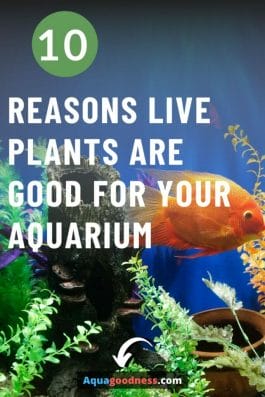If you want to keep plants in your aquarium but you are concerned if they are good or not then you are in the right place.
In this article, I will tell you everything you need to know about aquarium plants. So you can make an informed decision about whether you should keep plants in your aquarium or not.
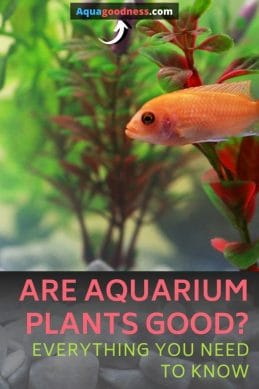
Table of Contents
So, are aquarium plants good?
The short answer is yes. Live plants provide a lot of benefits such as they produce oxygen in your fish tank and consume carbon dioxide and ammonia which is harmful to your fish.
They also help to emulate the natural habitat of your fish and provide them shelter and security.
Besides, there are a lot of benefits to keeping live plants in an aquarium.
Pros and Cons of keeping live plants in your aquarium
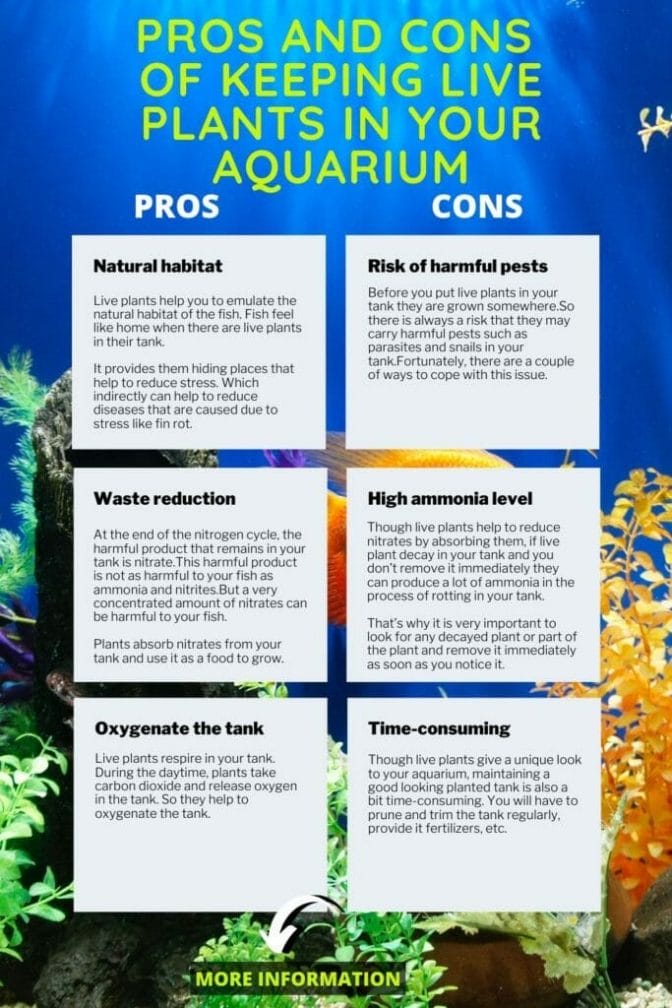
Live plants look very good in the aquarium and there are a lot of other benefits of keeping live plants in your aquarium.
But you will also have to take care of live plants to maintain the aesthetics and ideal environment in your tank.
This is the reason many beginners get intimidated by the idea of keeping live plants in their aquarium.
Also, there are certainly some cons of keeping live plants in an aquarium.
10 Best Live Plants For Guppies
Pros of keeping live plants in an aquarium
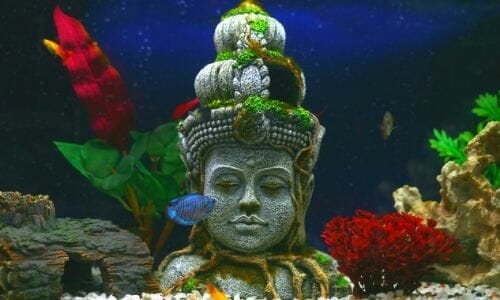
There are a lot of benefits of keeping live plants in the tank.
1. Natural habitat
Live plants help you to emulate the natural habitat of the fish. Fish feel like home when there are live plants in their tank.
It provides them hiding places that help to reduce stress. Which indirectly can help to reduce diseases that are caused due to stress like fin rot.
2. Waste reduction
At the end of the nitrogen cycle, the harmful product that remains in your tank is nitrate.
This harmful product is not as harmful to your fish as ammonia and nitrites.
But a very concentrated amount of nitrates can be harmful to your fish.
And there are only two ways to reduce nitrates in your tank
- Doing water change
- Adding plants in your tank
Plants absorb nitrates from your tank and use it as a food to grow.
3. Oxygenate the tank
Live plants respire in your tank. During the daytime, plants take carbon dioxide and release oxygen in the tank. So they help to oxygenate the tank.
9 Best Oxygenating Plants for Aquarium (and Pond)
4. Encourage spawning
In the wild, some species of fish lay their eggs on the leaves of the plant.
The plants act as a protection for the eggs and fish feels safe to lay their eggs on plants. So, if you keep plants in your tank then you can expect more frequent spawning in your tank.
Besides, it is very interesting to see the natural spawning behavior of fish in your tank.
5. Sell plants for profit
Once you have an established planted tank then sometimes you will find you will have some leftover plants after the maintenance of the tank. You can actually sell these plants online on eBay or on Craigslist.
You can also take these plans to your local fish store and they’ll buy from you.
Or at least they can give you a discount on your purchases.
In fact, local fish stores actually prefer to buy fish or plants from the aquarists than from any wholesaler.
6. Beneficial bacteria
Fish produces waste in the form of ammonia. And ammonia can be very harmful to your fish.
There are bacteria called beneficial bacteria that help to break down the harmful ammonia into less harmful nitrites and nitrates.
Live plants nurture beneficial bacteria that ultimately help to reduce ammonia in your tank.
7. Food for your fish
If you are keeping herbivorous or omnivorous fish in your fish tank then live plants can be a very tasty meal or snacks for your fish.
Do Goldfish Eat Plants? (And the Best Plants for a Goldfish Aquarium)
8. Reduce algae growth
Live plants help to reduce the algae growth in your tank by reducing nitrates.
Besides, live plants and algae compete for nutrients in your tank which also helps to reduce algae growth in your tank.
9. Substrate health
Aquarium plants help to maintain good substrate health and maintain a good environment in your aquarium.
When you have a deep substrate the oxygen cannot reach the deeper level of the substrate.
Which causes the formation of anaerobic bacteria in this area. And this bacteria produces toxic gas known as hydrogen sulfide.
Over time this gas builds up in the deeper level of the substrate. And ultimately it will release in the form of bubbles in your tank.
This gas is very toxic for your fish and it can be deadly.
Root feeder aquarium plants solve this problem.
The roots of the root feeder aquarium plants grow deep into the substrate that breaks down these anaerobic bacteria pockets. So the hydrogen sulfide gas will not build up and cause any problem to your fish in your tank.
10. Unique look to the tank
Live plants also offer you an opportunity to aquascape your aquarium and give it a beautiful and unique look.
6 Tips to Take Care of Live Plants in Aquarium (For Beginners)
Cons of keeping live plants in your tank
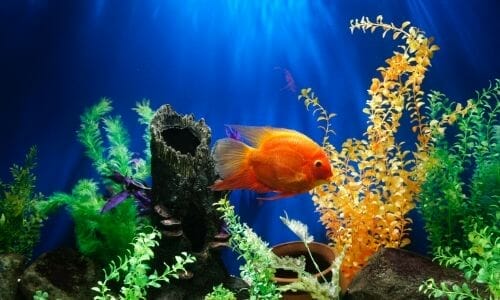
Though live plants look beautiful in the tank and they provide a lot of benefits, there are certainly some cons of keeping live plants in the tank.
1. Oxygen deficiency
Though aquarium plants produce oxygen in the daytime by the process of photosynthesis. At night, however, they take Oxygen and release carbon dioxide in the tank.
Usually, for normal aquarium, oxygen deficiency will not cause due to aquarium plants.
However, if you have a very heavily planted tank oxygen deficiency can occur at night time.
The way to solve this issue is to run an air pump during the night.
How to Increase Oxygen in Fish Tank? (8 Simple Ways)
2. Risk of harmful pests
Before you put live plants in your tank they are grown somewhere.
So there is always a risk that they may carry harmful pests such as parasites and snails in your tank.
Fortunately, there are a couple of ways to cope with this issue.
After getting the plants, you can soak them for an hour or so in a very mild bleach solution (half tablespoon bleach for gallon water).
Then you should clean them with running tap water and put them in a bucket containing tap water overnight.
Before putting it into the bucket of tap water, just make sure to dechlorinate it.
You can easily dechlorinate the water using a dechlorinating agent.
Another way is to clean the leaves of the plant using first aid antiseptic that is hydrogen peroxide solution.
Then wash it with tap water and again put it in the bucket containing the dechlorinated tap water for overnight and then plant them in your aquarium.
3. High ammonia level
Though live plants help to reduce nitrates by absorbing them, if live plant decay in your tank and you don’t remove it immediately they can produce a lot of ammonia in the process of rotting in your tank.
That’s why it is very important to look for any decayed plant or part of the plant and remove it immediately as soon as you notice it.
9 Ways to Lower Ammonia Level in Aquarium and Get Rid of it
4. Mess up the look of your tank
Though live plants can be used to produce beautiful aquascapes in the tank if your fish nibble on the plants very extensively then it can actually spoil the look of your tank.
So you have to choose the plants that are compatible with your fish i.e. the plants your fish will not eat.
Can You Put Live Plants with Oscars? (Best Plants for Oscars)
5. Time-consuming
Though live plants give a unique look to your aquarium, maintaining a good looking planted tank is also a bit time-consuming. You will have to prune and trim the tank regularly, provide it fertilizers, etc.
6. Extra cost
Besides buying the plants there is also an extra cost of fertilizers, compatible lighting, etc.
The thing is, plants require a lot of macro and micro nutrients for their proper growth.
They can get some nutrients from the substrate of the freshwater aquarium but you’ll have to use fertilizers to provide other essential nutrients.
Besides, different plants have different light requirements. And usually, the inbuilt light that comes with the aquarium is not strong enough. So you have to buy lighting for your tank which is an extra cost.
7 Best Aquarium Plants For Tetras
How to choose live plants for an aquarium?
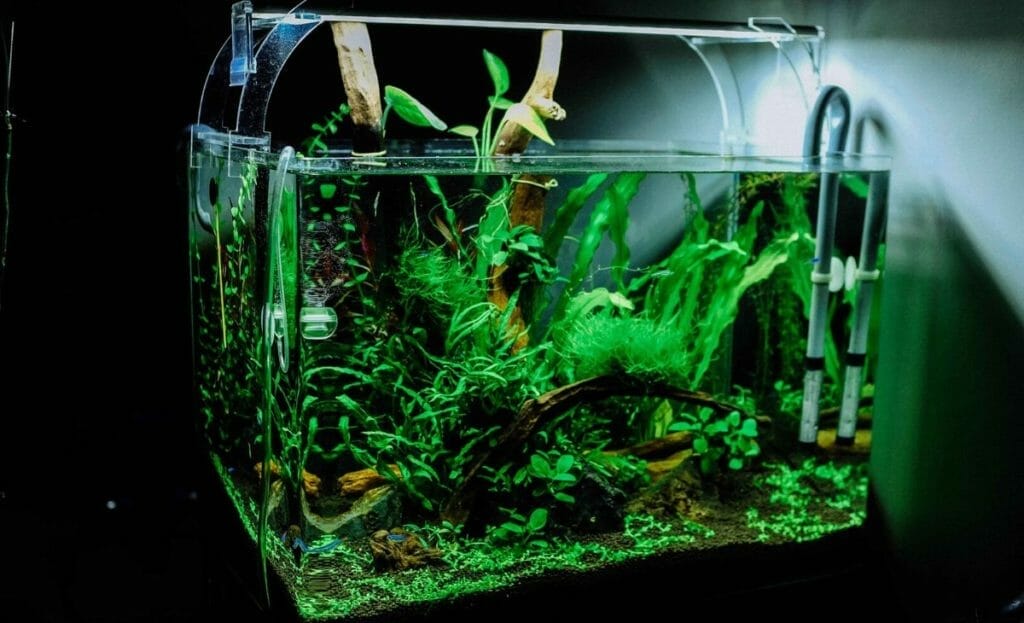
Choosing aquarium plants that are not only right for your aquarium but also right for you is very important.
If you are just starting out then I highly encourage you to start with some hardy and low maintenance aquarium plants.
I have written a detailed article about the best aquarium plants for beginners.
Now I will share with you some tips that you should keep in mind while choosing aquarium plants for your aquarium.
Design
First of all, you should visualize how you want your aquarium to look. Sounds interesting, right?
Four levels of your tank
To better design your tank you should visualize your thank in 4 different parts.
- The background
- The midground
- The foreground.
- And the water surface of the tank
At each level, you are going to choose the plants that have particular characteristics.
Background aquarium plants
In the background of your aquarium, you should keep tall-growing plants such as Jungle Vallisneria, Java fern, Cabomba, etc.
If you have a smaller tank then you should avoid keeping very bushy plants in the background of your tank unless you don’t want to keep midground aquarium plants in your tank.
I have written a detailed article covering the best background aquarium plants.
Midground aquarium plants
Midground is the main focal area of your aquarium.
You don’t want this area to get cluttered with plants and you should keep open space for your fish to swim around.
In this area, you should choose slow-growing aquarium plants that can grow to a moderate height.
A few good examples of mid-ground aquarium plants include Anacharis, Java fern, etc.
Foreground aquarium plants
In the foreground of your aquarium, you should keep slow-growing, short aquarium plants, or carpeting plants i.e. the plants that cover the ground of your aquarium.
Some good examples of foreground aquarium plants include Anubias, Micro sword grass, Java moss, etc.
9 Best Aquarium Plants For Shrimp
Surface aquarium plants
Surface aquarium plants are commonly known as floating aquarium plants.
These plants don’t require any substrate and they just float on the surface of the water of your tank.
You have to be careful while keeping floating plants in your tank if you have other plants planted in the substrate of your tank. Because floating plants can block light coming into the tank which can affect the growth of the plants that are planted in the substrate.
Floating aquarium plants also provide a great place for fish fry to hide in your tank.
Visual effect
To create nice visual effects and contrast in your tank you can keep plants that have larger leaves with the plants that have thin leaves.
You can also add some red aquarium plants with your green aquarium plants.
I have written a detailed article about the best red aquarium plants.
Tank size
Tank size plays a very important role while choosing plants for aquarium.
According to the tank size of your tank, you are going to choose plants for your tank.
If you are just starting out and you have a small tank then you should avoid keeping very tall growing and fast growing aquarium plants.
Because you will have to keep an eye on it and trim it very frequently.
Water conditions
While choosing aquarium plants for your aquarium one of the most important things to keep in mind is that the plants you choose should require similar water conditions i.e. pH, hardness, water temperature, etc that the fish in your tank requires. So that they can thrive in the same tank.
For example, if you have a Goldfish tank then as Goldfish requires coldwater, you’ll have to keep the aquarium plants that do well in cold water.
Substrate
The substrate of your tank can be very important for the proper growth of aquarium plants.
There are some aquarium plants like Amazon sword, Ludwigia repens, Cryptocoryne wendtii that are root feeder which basically means that they draw most of the nutrients through their roots.
Usually, these plants do well in a nutrient-rich substrate.
You can plant them in sand or gravel substrate but then you will have to supplement them with root tabs to fulfill their nutrients need.
Besides, there are some plants that draw nutrients through their leaves.
You can plant such plants in any substrate of your choice.
You can even tie them to any ornament in your tank like driftwood or rock. Or you can even keep them floating in your tank.
8 Best Aquarium Plants That Grow On Driftwood and Rock
Fast growing and slow-growing aquarium plants
Ideally, you should avoid keeping very fast growing plants next to slow-growing plants. Because fast growing plants can draw nutrients very quickly that can lead to nutrient deficiency in your slow-growing plants.
Besides, if you are going to keep fast growing plants in your tank then you should always keep an eye on them and regularly trim them whenever needed.
14 Best Fast Growing Aquarium Plants (without CO2)
Light requirements
Lighting is one of the most important factors when it comes to plant growth.
There are both high light aquarium plants and low light aquarium plants in the aquarium hobby.
And usually, the lighting inbuilt lighting setup that comes with your tank is not sufficient for most of the plants.
But there are some plants that can do well in almost any lighting condition like Duckweed.
Besides, some red aquarium plants can do fine in low lighting condition but they will require high lighting conditions for the red coloration.
So, while choosing the plants you should do the research and find out how much lighting you will have to provide them.
7 Best Aquarium Plants For Angelfish
How to keep live plants in an aquarium?
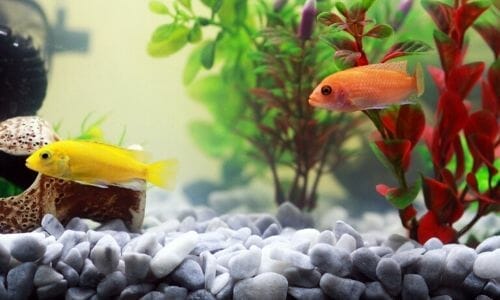
If you have a new aquarium and the nitrogen cycle is not completed in the tank then you should start with some hardy plants.
If you choose sensitive plants then they might die in a new aquarium.
You can always plant sensitive plants once the nitrogen cycle is completed and your tank is well established.
Preparing plants for planting in the tank
Once you got the plants at home, first of all, you should remove its rubber band and cut down dead leaves, roots, and stems from the plant.
As mentioned earlier, live plants also carry the risk of transferring harmful pests in your tank.
That’s why it is very important to clean the plants before planting them in your tank.
There are a couple of ways to do so.
1. Using a bleach solution
Once you got the plants you can soak it in a very mild bleach solution about a half teaspoon for a gallon for an hour or so.
Then you should wash the plants with running tap water and put it in a bucket containing dechlorinated water overnight. And then you can plant them in your aquarium.
2. Using hydrogen peroxide solution
Some people also use hydrogen peroxide solution i.e. first aid antiseptic solution instead of bleach.
The process is the same. First, you soak the plants in a solution of water and hydrogen peroxide for an hour or so.
Then wash it with running tap water and then soak it in chlorinated tap water overnight. And then plant them in your aquarium.
8 Best Aquarium Plants for Sand Substrate (Easy to Care and Maintain)
Planting aquarium plants in the aquarium
Once you prepared or clean your aquarium plants then it is time to plant them in your aquarium.
If you are planting aquarium plants in a new tank then before planting the plants make sure to wet the substrate with water and then start planting the plants.
Besides, you have to plant different types of plants differently.
Rosette plant
Rosette plants are the plants that have roots at its base.
These plants have a lot of long roots.
Before planting them in your aquarium, you have to cut its long roots and keep only about 2 inches long roots.
To plant these plants just make a hole into the substrate with your finger and then put it into the hole.
Stem plants
Usually, stem plants are very sensitive and their roots grow near their nodes.
You don’t have to plant stem plants in your aquarium. You can just simply tuck it into the substrate and its roots will grow automatically in the substrate.
Besides, you can also tie it to driftwood or rock and its roots will grow automatically.
Rhizome plants
Rhizome plants don’t have true roots and you don’t need to plant them in your substrate.
You can tie it to driftwood or rock with thread. Or you can glue it to the driftwood for rock.
Floating plants
Floating plants don’t require any substrate. And you don’t need to plant it into the substrate or tie it to any driftwood or rock. You can just let it float in your aquarium.
13 Best Aquarium Plants That Can Grow Without Substrate
Feeding aquarium plants
Plants require various micro and macro nutrients for their proper growth.
Many micronutrients like oxygen, hydrogen, nitrogen, etc are usually present in the substrate of the well-maintained aquarium.
But plants also require micronutrients like magnesium, potassium, carbon, sulfur, phosphorus, etc for their proper growth.
Fertilizers can provide these micro and macro nutrients to your plants.
That’s why for a healthy and lush plant you need to regularly feed them fertilizers.
How to provide fertilizers to aquarium plants?
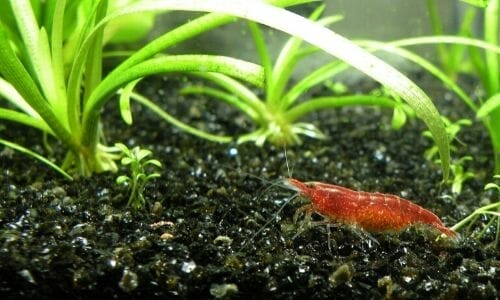
There are several ways you can provide fertilizers to your aquarium plants.
Substrate
You can use a nutrient-rich or soil-based substrate in your aquarium to plant aquarium plants.
This substrate contains all the essential nutrients that your aquarium plants require.
You should use this substrate if you have root feeder aquarium plants because these plants draw nutrients through its roots from the substrate.
10 Best Root Feeder Aquarium Plants (Easy Aquarium Plant Varieties)
Root tabs
If you already have sand or gravel substrate in your aquarium and you are going to plant root feeder aquarium plants then a very good way to provide fertilizers to the plants is by using root tabs.
Root tabs are slow releasing fertilizers. You just have to put root tabs near the roots of your aquarium plants and it will provide all the micro and macro nutrients that your aquarium plant requires.
Besides, if your tank already has a nutrient-rich substrate, over time what happens is that the plant will draw all the nutrients from the substrate. And then the plant will not have sufficient nutrients to draw from the substrate.
So a good way to provide nutrients to the plant is by supplementing the plant with root tabs.
13 Best Aquarium Plants For Gravel Substrate
Liquid fertilizers
There are a lot of aquarium plants that draw nutrients from its roots as well as from its leaves.
Also, there are some aquarium plants that draw nutrients only through their leaves.
To provide all the nutrients to such plants you have to use liquid fertilizers.
You should add liquid fertilizer after the water change.
7 Best Aquarium Plants That Don’t Need Fertilizers
Lighting for live aquarium plants
Lighting is one of the most important factors when it comes to the proper growth of aquarium plants.
Plants require light to create their own food by photosynthesis.
Light also helps live plants to absorb carbon dioxide exhaled by fish in your aquarium.
But too much light is also bad for you your aquarium because it can cause algae growth.
On the other hand, if you provide very weak light to your plants then your plants will suffer.
So, you will have to provide light according to the lighting requirements of the plants you are going to put in your tank.
What is the best light for aquarium plants?
There are three options available when it comes to lighting for aquarium plants
- Old school incandescent lighting
- Fluorescent lighting
- LED lighting
If you are already using incandescent lighting in your tank then it should be at least 25 Watts per square foot of your aquarium.
Besides, there are several reasons you should avoid incandescent lighting for your tank
- First of all, incandescent lighting is very expensive to maintain compared to fluorescent and LED lighting
- The lifespan of the incandescent light bulb is also very short.
- Besides, incandescent lighting is very inefficient and it cannot penetrate below 12 inches depth.
- Incandescent lighting can produce a lot of heat and it can raise the temperature of the water on the surface of the tank.
So, now we are left with two good options that are fluorescent and LED lighting.
15 Ways to Lower Temperature in an Aquarium (With and without Equipment)
Fluorescent lighting
There are two different types of fluorescent lights,
- Fluorescent lighting.
- Compact fluorescent lighting.
If you are going to use fluorescent lighting in your aquarium, just be sure to check that the light bulb used in the fixture is ideal for aquarium plant growth.
The thing is, the light spectrum that the aquarium plant requires is different than the light spectrum of a normal fluorescent bulb.
LED lighting
LED lighting is the best lighting you can provide to your aquarium plants in your tank.
Benefits of LED light
- LED lighting can penetrate up to 24 inches easily.
- Even the inexpensive LED lighting is sufficient for the proper growth of aquarium plants.
- LED lighting is also very inexpensive to maintain.
- And there are some types of LED lighting that come in a waterproof glass tube.
- There are also some LED lights that come with a remote that allows you to set different light color and intensity.
- Besides, there is continuous innovation going on in the LED lighting.
How much time should I keep lights on in my aquarium?
How much time you should keep the lights on in your aquarium varies depending on the location your aquarium is placed.
First of all, you should avoid keeping your aquarium in the place where it can get direct sunlight. Because it can cause very rapid algae growth.
If you have placed your aquarium near window where it gets a lot of natural light then you may need to keep the artificial lights on for only 5 hours every day.
Ideally, you should keep your aquarium away from the window. And depending on the plant in the aquarium you should provide light anywhere between 8 to 12 hours every day.
Consistency is very important!
Consistency is very important when it comes to lighting for aquarium plants.
Either you should get lighting that has the inbuilt timer. Or you can buy a timer separately to turn on and off the light on the specific timing every day.
If you keep the lights on for more time then it can cause algae growth. And it can take several weeks to months to fix the problem.
On the other hand, if the plants didn’t get enough lighting then it can die.
9 Best Flowering Aquarium Plants (Underwater and Overwater)
Recommended aquarium plants for beginners
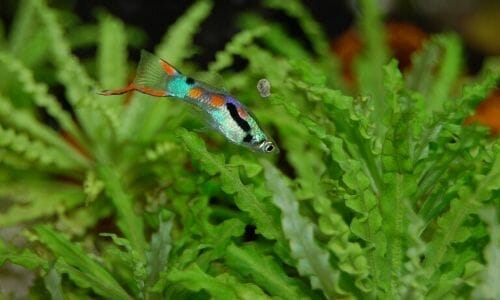
If this is your first time to keep live plants in your aquarium then I highly encourage you to try a few plants from the list below. These are pretty hardy and low maintenance plants.
- Anacharis
- Java moss
- Java fawn
- Cryptocoryne wendtii
- Amazon salt sword
- Ludwigia repens
- Hornwort
I have written a detailed article covering all the requirements of these plants and some more plants in this article.
FAQ
How long do aquarium plants live?
The lifespan of aquarium plants is really dependent on the species of plant.
There are some aquarium plants that can live only for one year. And there are other aquarium plants that will never die in your aquarium as far as they are getting the ideal environment in the tank.
Basically, there are three types of aquarium plants.
- Annual plants
- Biennial plants
- Perennial plants
Annual plants usually live for only one season.
Biennial plants live for multiple seasons.
And perennials plants will never die as far as they are getting a good environment.
15 Things You Must Know Before Buying Your First Aquarium
How often should you change live plants in a fish tank?
You don’t really need to change live plants in your fish tank unless you are not happy with the existing species of plants and you want to replace them with some other species of plants.
If you are ok with the existing species of plants in your tank then you just have to trim them if needed.
If you notice any brown or dead leaves then you can simply cut them off and remove them from the tank.
Are Your Aquarium Plants Turning Brown? Here’s what to do.
Are plastic plants bad for fish?
If you are going to plant high-quality plastic plants in your tank then they are totally fine for your fish.
But with the plastic plants, you don’t get the benefits that live plants offer.
Can live plants kill my fish?
There are some plants that are not meant for your fish. And if your fish consume such plants then it can cause health issues with your fish.
So, if you choose compatible live plants for your fish then it is very unlikely that your fish will get killed by live plants.
The only scenario your fish may get killed due to live plants is when you have a heavily planted tank. And as plants exhale carbon dioxide during the night, at night, oxygen deficiency can occur in the fish tank and this can lead to the death of your fish.
The way around this issue is to keep an air pump on during the night. The air pump will help to oxygenate the tank at night.
How does fish waste help plants grow?
Fish waste produces ammonia which actually provides essential nutrients to the aquarium plants.
It is like food for aquarium plants. So when aquarium plants absorb fish waste, it helps to grow them.
Do live plants keep an aquarium clean?
Yes, live plants help to keep the aquarium clean by absorbing ammonia from the tank.
What are the easiest plants to grow in an aquarium
There are a lot of species of plants available that are easy to keep.
If you are a beginner, I highly encourage you to check out this article where I have covered all the 52 best freshwater aquarium plants that are good for beginners.
20 Tips to Maintain a Healthy Aquarium
Conclusion
So, are aquarium plants good? Yes, aquarium plants are a good addition to any aquarium because there are a lot of benefits of keeping live plants in the tank.
But you do have to take care of them and it does take a little time and practice.
If you are a beginner, I highly encourage you to try with some hardy low maintenance plants.
Once you got your feet wet then you can try other exotic plants.
I hope you found this article helpful.
If you do, please share it.
As always, happy fish giving!
